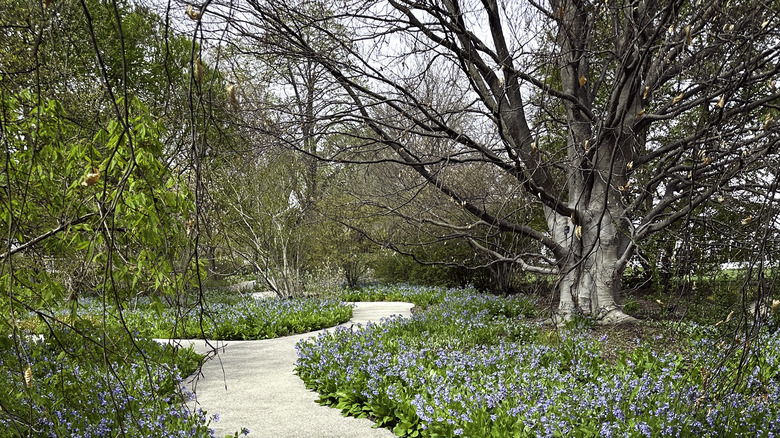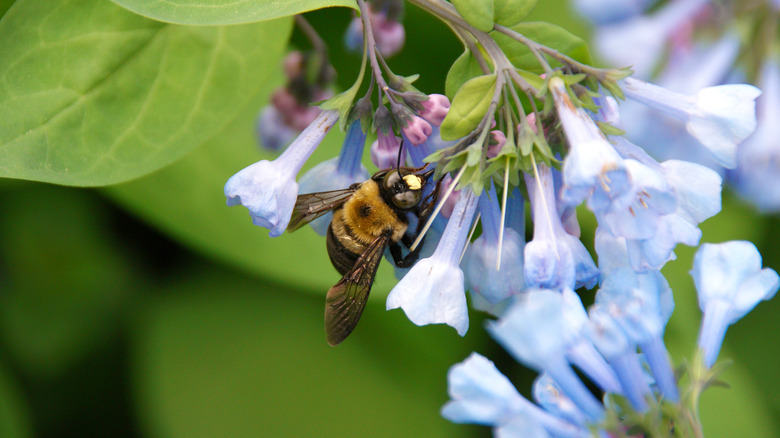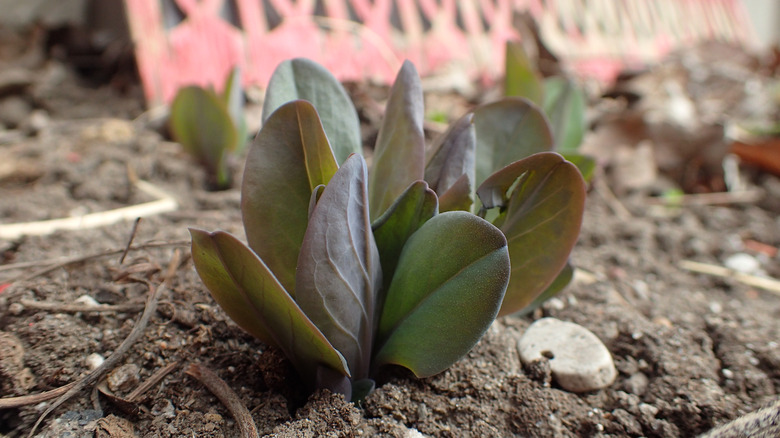Plant Virginia Bluebells To Bring Hummingbirds & Other Beauties To Your Yard
Love Spanish bluebells or grape hyacinths for their bird-attracting blooms but dislike the havoc they wreak on your yard? While pretty, they quickly become the gorgeous flower you'll wish you never planted in your garden due to their tendency toward invasiveness. Replace them with Virginia bluebells. This shade-loving home garden favorite offers a feast of pink and lavender-hued flowers with a tubular shape and mild fragrance that nectar-loving birds (the hummingbird included) and insects can't resist. Plus, the Virginia bluebell is unlikely to overtake your carefully cultivated understory since it dies down once summer arrives.
The Virginia bluebell (Mertensia virginica) is native to eastern North America (it thrives in USDA Hardiness Zones 3 to 9) and is probably the most well-known of the forty or so Mertensia bluebells. In the 18th century, it was referred to as Jefferson's blue funnel flowers because they grew in Thomas Jefferson's home garden. You might also know it by other common names, including Virginian cowslip, Virginian spiderwort, blue iris, mountain cowslip, Roanoke bells, and lungwort oysterleaf. Blink, and you'll miss this short-lived — at least where foliage and flowers are concerned — perennial nestled into shady, damp spots in forests and floodplains. In early spring, the plant pushes deep purple prongs out of the earth that transform into blue-green foliage and flower stalks reaching a foot tall. It blooms only from April through May but sometimes into early June, depending on the location. By summer, it's gone, lying dormant under the ground until next season.
Blooms for the birds and bees
Planting Virginia bluebells is just one of the many genius tips and tricks to attract more hummingbirds to your garden. But why do these tiny gemstones on wings like the plant? While not a favorite, hummingbirds — particularly ruby-throated hummingbirds – won't turn their beaks up at any blooming plants they encounter as they migrate north in the spring. For one, hummers can't resist tube-shaped flowers — feasting on the nectar deep inside is why they have extremely long tongues, after all. And while it's well-known hummingbirds love red flowers, they're also rather partial to pink and purple blooms, especially if they're shaped like a trumpet and hang downwards in a bell-like fashion.
Of course, with all that nectar and pollen bottled up inside the flowers that are among the earliest to appear in the spring, it likely comes as little surprise that Virginia bluebells are even more attractive to pollinating insects. Number one on the list of fast fans are long-tongued bees — think honeybees, digger bees, and mason bees. Not far behind them are various native moths, butterflies, and skippers, most notably Sphinx moths like the hummingbird moth. Like with hummingbirds, the flowers' pink and purple hues signal to the insects that there's a snack inside. Flower flies and bee flies can't get enough of them, either. In fact, the Virginia bluebell, being native to the U.S.A., is critical to the survival of these equally localized insects.
Plant and care for it
Sadly, this plant faces extinction in some places — Michigan, for example — due to habitat loss and flood prevention. As such, never wild-harvest Virginia bluebells. Instead, get plants from native plant nurseries or nature group giveaways. Native Wildflowers Nursery will ship you three bare root slips for $17.97, or you can get a three-pack of bare root stock from Nature Hills Nursery for $44.99. Established plants multiply by rhizomes (sometimes called bulbs), making them easy to grow from root cuttings. Help a neighbor divide a thriving patch in fall or early winter when the plant is dormant, and take some bulbs home. Growing Virginia bluebells from seed is less popular but possible. Buy a 20-seed pack from Ferri Seeds for $6.
With your Virginia bluebell seeds or plants in hand, it's time to learn how to care for bluebell flowers. After all, healthy plants bloom better, maximizing hummingbird and pollinator attractant potential. Choose a damp spot in your garden with partial to full shade, ideally under deciduous trees, so the patch gets spring sun. Since the Virginia bluebells disappear from summer through winter, interplant them with greenery that thrives in similar conditions — wild ginger, Christmas, lady, or cinnamon ferns, wild geraniums, wood poppy, and hostas. Expect blooms two or three years after planting and cut the foliage back after flowering to aid dormancy. Best of all, Virginia bluebells are basically set and forget. Few pests or diseases bother them, and deer and rabbits largely ignore them.


